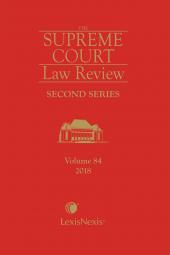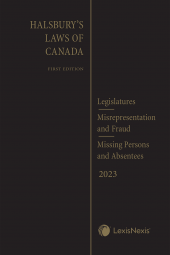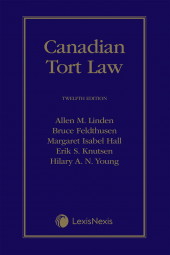The Law of Nuisance in Canada, 2nd Edition
One Year Subscription Only Terms
Subscribers receive the product(s) listed on the Order Form and any Updates made available during the annual subscription period. Shipping and handling fees are not included in the annual price.
Subscribers are advised of the number of Updates that were made to the particular publication the prior year. The number of Updates may vary due to developments in the law and other publishing issues, but subscribers may use this as a rough estimate of future shipments. Subscribers may call Customer Support at 800-833-9844 for additional information.
Subscribers may cancel this subscription by: calling Customer Support at 800-833-9844; emailing customer.support@lexisnexis.com; or returning the invoice marked 'CANCEL'.
If subscribers cancel within 30 days after the product is ordered or received and return the product at their expense, then they will receive a full credit of the price for the annual subscription.
If subscribers cancel between 31 and 60 days after the invoice date and return the product at their expense, then they will receive a 5/6th credit of the price for the annual subscription. No credit will be given for cancellations more than 60 days after the invoice date. To receive any credit, subscriber must return all product(s) shipped during the year at their expense within the applicable cancellation period listed above.
Détails des produits
This legal treatise provides a comprehensive review of the law of public and private nuisance and strict liability as applied and articulated in Canadian cases. The authors have found in their research that even though the law of nuisance can be difficult to navigate, with each case being judged in its own context, there "are many common threads and basic statements of principle that do act as milestones and beacons." They have used these basic guiding principles, as found in current Canadian law, to help illuminate the way for others.
Nuisance is interference with the use and enjoyment of the land belonging to another. In general terms, nuisance law can be divided into two types of actions that, while similarly named, have little in common with each other:
- Private nuisance relates to the use of one person's land in a way that interferes with another person's enjoyment of their land. Classic examples are smells, smoke, and noise that emanate from land A that annoy the owner of land B. More contentious are aesthetic infractions, such as loss of pleasant view.
- Public nuisances are interferences with rights owed to the population at large, such as damage to waterways, or interference with the right of public passage on streets, and are mostly covered by statute
Because the elements of a cause of action in nuisance are quite different from those relating to negligence (which covers the quality of the defendant's conduct, fault, and foreseeability), often a nuisance action will provide a remedy which would otherwise be unavailable (such as an injunction preventing further annoyance, as opposed to financial redress for negligence).
Features and Benefits
- Provides commentary and analysis of jurisprudence, offers a coherent overview of the topic, clarifies the law and helps to avoid costly mistakes
- Offers extensive case law references, saving research time and costs
- Analyzes the various types of nuisance law so that you may:
- Determine whether a cause of action may exist and the chances of success in pursuing it; and
- Identify the potential types of nuisance that may assist clients such as advocacy and special interest groups in furthering their goals
What's New In This Edition?
This second edition incorporates more than 100 cases decided by all levels of Canadian courts since its original publication in 2010. Numerous authorities have been added to the footnotes and discussion has been added on emerging issues such as: class actions for private nuisance; the role of aboriginal title in claims for private nuisance; and the continuing interface between nuisance law and fault and causation. This edition also considers recent significant cases from Canadian appellate courts and the Supreme Court of Canada, such as Smith v. Inco (Ontario Court of Appeal) and Antrim Truck Centre Ltd. v. Ontario (Transportation) (Supreme Court of Canada).
A Must-Have Resource For
- Lawyers – litigation lawyers, in-house and corporate counsel (especially those whose companies have land holdings), landlord-tenant lawyers, municipal lawyers, environmental lawyers and lawyers for public advocacy and special interest groups
- Construction companies
- Companies in "nuisance-causing" industries – any business that may receive complaints of excessive noise, smell or other interference to others
- Advocacy and special interest groups
- Academics
Table des matières
Chapter I: Introduction to Nuisance
A. Vilification and Vindication
B. Nuisance and Negligence: Fault, Foreseeability, Reasonableness, and Causation
C. Nuisance and Trespass: Damage, Indirectness, and Continuity
D. Statutory Nuisances and Remedies
E. History of Nuisance (by Christopher Harvey, Q.C., Ph.D.)
Chapter II: Public Nuisance
A. Scope and Meaning of Public Nuisance
B. Interference with Public Rights
C. The Balance of Reasonableness
D. Element of "Special Damage"
Chapter III: Private Nuisance
A. Scope and Meaning of Private Nuisance
B. Balance of Reasonableness
C. Standing: The Plaintiffs Interest in the Affected Land
D. Other Boundaries of Liability: The Source of the Nuisance, Fault, Knowledge, Vicarious Liability, and Joint and Several Liability
Chapter IV: The Rule from Rylands v. Fletcher
A. Introduction
B. Rylands v. Fletcher
C. Substances, Activities and Accumulations Subject to Rylands
D. Escape
E. Damage and Causation
F. Situating Rylands as a Theory of Strict Liability
G. Conclusion
Chapter V: Defences in Nuisance (Public and Private) and Rylands
A. The Ineffectual Defences
B. Statutory Immunity
C. Statutory Authority
D. Contributory Fault and "Coming to the Nuisance"
E. Consent, Acquiescence, Estoppel (volenti non fit injuria)
F. Act of Third Party
G. Act of God (vis major, force majeure)
H. Prescription (Adverse Possession)
I. Limitation Period and the Continuing Cause of Action
Chapter VI: Remedies
A. Introduction
B. Abatement
C. Injunctions
D. Damages
Chapter VII: Criminal Nuisance
A. Introduction
B. Commission of Unlawful Act or Failure to Discharge Legal Duty
C. Endangerment to the Public
D. Causation and "Coming to the Nuisance"
Index
Produits liés
-
 Supreme Court Law Review, 2nd Series, Volume 84Date de sortie: April 18, 2018295,00 $
Supreme Court Law Review, 2nd Series, Volume 84Date de sortie: April 18, 2018295,00 $ -
 Halsbury's Laws of Canada – Legislatures (2023 Reissue) / Misrepresentation and Fraud (2023 Reissue) / Missing Persons and Absentees (2023 Reissue)Date de sortie: April 25, 2023335,00 $
Halsbury's Laws of Canada – Legislatures (2023 Reissue) / Misrepresentation and Fraud (2023 Reissue) / Missing Persons and Absentees (2023 Reissue)Date de sortie: April 25, 2023335,00 $ -
 Canadian Tort Law, 12th EditionDate de sortie: April 18, 2022435,00 $
Canadian Tort Law, 12th EditionDate de sortie: April 18, 2022435,00 $
 Lexis Nexis
Lexis Nexis 